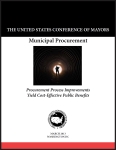|
May 9, 2013
U.S. Conference of Mayors Calls for Reform in Water Pipe Procurement
 According
to a new report by the U.S. Conference of Mayors (USCM), an estimated $2.28
trillion in water and sewer pipes are needed over the next 20 years to upgrade
the nation’s deteriorating underground infrastructure. Updating procurement
policies could reduce this figure substantially, spur innovation and help
realize much-needed cost-savings. Unfortunately there is a tendency for many
utilities to simply buy traditional materials like ductile iron pipe without
reviewing other options. Instead, water and sewer utilities should be focused on
finding savings and efficiencies through open pipe selection practices.
Click here
for study. According
to a new report by the U.S. Conference of Mayors (USCM), an estimated $2.28
trillion in water and sewer pipes are needed over the next 20 years to upgrade
the nation’s deteriorating underground infrastructure. Updating procurement
policies could reduce this figure substantially, spur innovation and help
realize much-needed cost-savings. Unfortunately there is a tendency for many
utilities to simply buy traditional materials like ductile iron pipe without
reviewing other options. Instead, water and sewer utilities should be focused on
finding savings and efficiencies through open pipe selection practices.
Click here
for study.
“The common practice of choosing metallic pipes without a full financial
evaluation continues to dominate procurement decision-making…Only by modernizing
procurement practices and the assumptions upon which pipes are selected can
municipalities achieve much needed cost-savings and performance improvements in
their underground infrastructure at a time of dwindling financial resources,”
says report author Richard F. Anderson, Ph.D., Senior Advisor, Mayors Water
Council.
Beware of Thinner-Walled
Ductile Iron Pipe Says USCM, It May Only Last 11 to 14 Years
Mr. Anderson
points out that thinner-walled ductile iron pipes “corrode and fail more quickly
than their thicker cast iron predecessors” and are more expensive to buy and
operate than corrosion-proof PVC pipe. For these and other reasons,
municipalities must undertake rigorous cost comparisons for all the piping they
buy. “Focusing on pipe material selection is the first step in reducing
system capital cost, and, subsequently, operations and maintenance costs (O&M),”
says Anderson.
Open Procurement and Financial
Analysis Prevents Over Building the System and Saves Money
 Traditional
pipe procurement often doesn’t take into account the additional costs of
corrosion mitigation or the loss in performance of metallic piping systems over
time because of corrosion. “The use of non-corrosive materials can help
reduce the overall costs of maintenance, operations and expensive capital
replacement plans,” argues Anderson. As well, today there is much less need
for more expensive water pipe that handles very high pressures since with
“modern system operation technology, pressure release valves and other
improvements the underground infrastructure is operated more efficiently and at
monitored levels…average water system supply pressure is only 77 psi with
pressure fluctuations of less than 20 psi.” Traditional
pipe procurement often doesn’t take into account the additional costs of
corrosion mitigation or the loss in performance of metallic piping systems over
time because of corrosion. “The use of non-corrosive materials can help
reduce the overall costs of maintenance, operations and expensive capital
replacement plans,” argues Anderson. As well, today there is much less need
for more expensive water pipe that handles very high pressures since with
“modern system operation technology, pressure release valves and other
improvements the underground infrastructure is operated more efficiently and at
monitored levels…average water system supply pressure is only 77 psi with
pressure fluctuations of less than 20 psi.”
“We hope that our report will provide solutions for local leaders to find more
cost-effective and efficient ways to manage their water systems, despite
challenging economic times,” says U.S. Conference of Mayors CEO and Executive
Director Tom Cochran.
Additional Findings:
-
Some 75% of
cities in the U.S. have corrosive soil conditions.
-
Corrosion and
soil conditions are major factors in determining pipe
performance.
-
PVC pipe has a
life expectancy in excess of 110 years and is unaffected by
corrosion.
-
Closed
procurement processes lead to unnecessary costs, and may
diminish public confidence in a local government’s ability
to provide cost-effective services.
-
Cities that have
reviewed their pipe material options and performed objective
analyses have chosen more cost-effective and better
performing pipe materials for their water systems.
-
Using a
non-corrosive material is critical to keeping long-term
maintenance costs down and minimizing capital replacement
budgets.
-
A utility
procurement manual or standard operating practice can simply
be updated to allow open competition for pipe materials.
Once this occurs, design and financial analysis can take
place to select the best value for a particular project.
Regards,
Bruce Hollands
Executive
Director | Uni-Bell PVC Pipe Association
2711 LBJ
Freeway, Suite 1000 | Dallas, TX 75234
T. 972.243.3902 ext. 1019 | C. 214.244.9202 | F. 972.243.3907
www.uni-bell.org
  
|